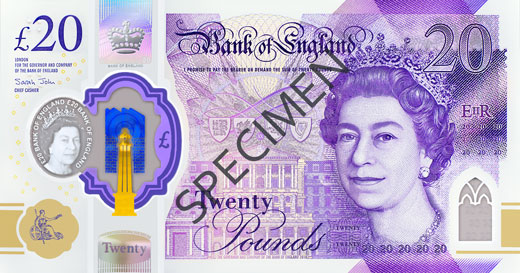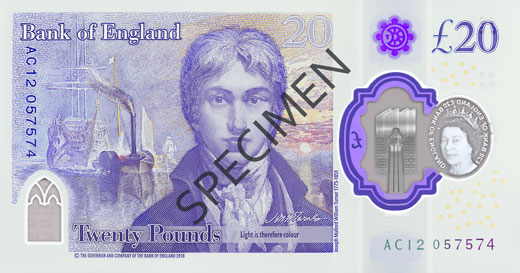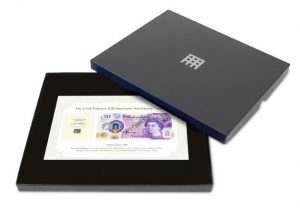Posts Tagged ‘£20 note’
The secrets hidden in Britain’s most secure banknote yet
Whether you love them or hate them, it’s fair to say that when the Bank of England issued the very first polymer banknotes, UK currency was revolutionised. As well as refreshing the designs of the notes, these polymer versions were considered a cleaner, safer and stronger alternative.
In 2016 it was the £5 that received the first makeover, and Winston Churchill was selected to feature on the note. Jane Austen soon followed on the £10 note and now, as chosen by the British public, renowned artist JMW Turner graces the new £20 polymer note.
But it’s not only the design that makes this note special. You see, the Bank of England have described this note as the most secure banknote yet. So, I’m of course curious to see what special security features have been worked into the design of our newest banknote…
Britain’s most secure banknote
Before the revolutionary polymer £20 came along, there were over 2 billion £20 paper notes in circulation. The sheer volume of them made the £20 note Britain’s most used, and consequently most forged, banknote.
So it’s understandable that the need to make it difficult to counterfeit was at the forefront of the designer’s mind! The result? A whole host of special features that make it harder to forge and stand out from other notes in circulation.
Let’s take a closer look at some of the security features incorporated into the design:

- Transparent windows – the foil in the large see-through window is blue and gold on the front, and silver on the back. Plus, there’s a second, smaller window in the bottom corner.
- Changing holograms – the hologram beneath the large clear pane will alternate between reading ‘Twenty’ and ‘Pounds’ depending on what way you tilt the note.
- The Queen’s portrait in the transparent window – the Queen’s portrait is printed on the window with ‘£20 Bank of England’ printed twice around the edge.
- Foil patches – a silver foil patch contains a 3D image of the coronation crown. There is a second purple foil patch which contains the letter ‘T’.
- Ultra-violet technology – under UV light, the number ’20’ appears in bright red and green on the front of the note, against a duller background.
- Raised dots – you’ll find three clusters of raised dots in the top left hand corner. This tactile feature helps blind and partially sighted people identify the value of the note.
JMW Turner design
When choosing the design for the £20 note, the Bank of England were spoilt for choice. They received over 29,000 nominations submitted by the general public. And the choice to select JMW Turner makes him the first British artist to ever feature on a UK banknote.

The note itself features Turner’s 1799 self-portrait, which is currently housed in the Tate Modern in London. And behind this you’ll notice one of his most recognisable works – The Fighting Temeraire. This famous painting is a tribute to the ship that played a pivotal role in in Nelson’s victory at the Battle of Trafalgar in 1805.
The final nod to Turner in the design comes from the quote “light is therefore colour”, alongside the signature taken from his will. The quote is taken from a lecture Turner gave in 1818 and is a reference to his innovative use of light, shade, colour and tone.
What do you think about the new £20 Polymer note? Let us know in the comments!
If you’re interested…
If you’re looking for a way to own this significant, revolutionary piece of British currency, then look no further than the UK 2020 £20 Polymer Banknote DateStamp™ issue. Each DateStamp™ issue has been postmarked by Royal Mail with the note’s first day of release – 20th February 2020 – forever ensuring its provenance.
First issues are always valued by collectors and by owning the DateStamp™ issue you will be one of just 2,500 collectors able to forever mark the date the new £20 polymer banknote entered circulation. We have a limited number available, so click here to find out more >>
Britain’s got a new polymer £5 note – but is it a UK first?
On 13 September, the Bank of England will issue a new £5. It will be the first-ever polymer (or “plastic”) banknote that they have issued.
But is it the UK’s first?
Well it is certainly not the first polymer banknote issued in the UK.
Last year Clydesdale Bank issued Scotland’s first polymer banknote to mark the 125th Anniversary of the Forth Roadbridge.
But it was Northern Ireland that beat everyone else to it with a commemorative polymer banknote in 1999 issued to mark the millennium.
So the new Bank of England £5 note is certainly not the first polymer note to be issued IN the UK but perhaps it is still the first UK-wide polymer banknote…
The murky question of legal tender
So this might surprise you. No Scottish or Northern Irish banknotes are legal tender.
Bank of England banknotes are – but only in England and Wales.
But don’t panic – if you live in Scotland or Northern Ireland – your money’s not worthless! Legal tender does not mean quite what you think. It has a very narrow technical definition which relates to your ability to pay a debt into a court.
In fact all Scottish and Northern Irish notes are considered “legal currency” across the whole of the UK. But that does not mean that they have to be accepted and it’s not unusual for English or Welsh shop owners to be reluctant to accept non-Bank of England notes.
So where does this all leave us?
The Northern Irish and Scottish polymer banknotes clearly beat the new fiver. But they were special commemorative issues with limited circulation and little recognition outside of their issuing nation.
The new polymer £5 note is certainly the first “legal tender” note issued in the UK but that’s not as important as it first seems.
It is, however, the first polymer banknote issued for ongoing circulation (rather than as a commemorative issue) which is generally accepted across the whole of the United Kingdom.
Mark the moment the UK £5 banknote changed forever…
Just 5,000 new UK Polymer £5 Notes have been reserved for a Limited Edition DateStamp™ release.
This is the VERY FIRST time that a DateStamp™ banknote has been released.




